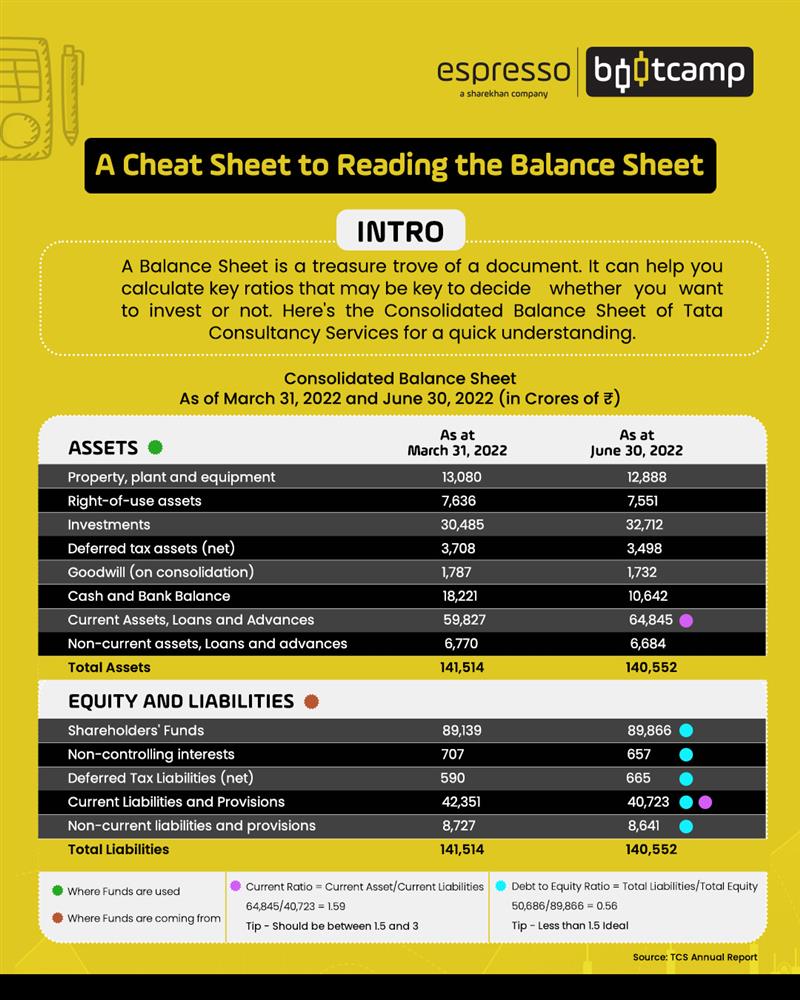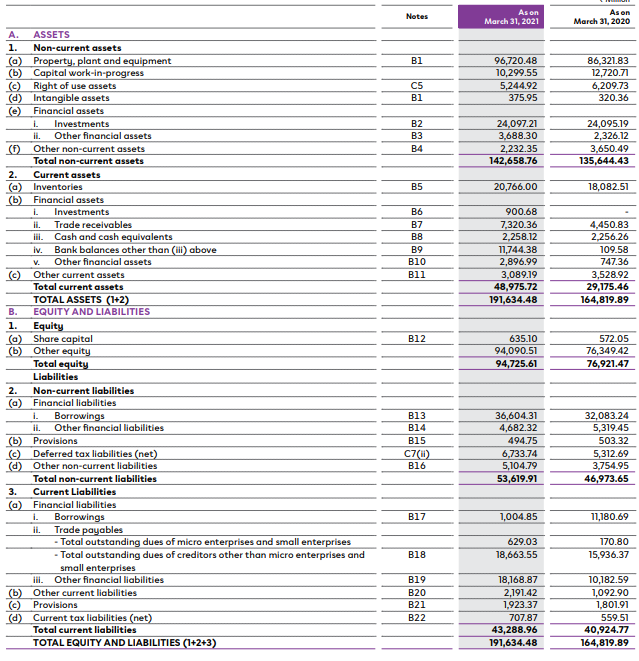 Let's begin with what is a balance sheet? A balance sheet is a snapshot of the financial condition of the company. An indispensable part of a company’s financial statements, it gives the synopsis of funds generated, their sources and how they are invested.
Let's begin with what is a balance sheet? A balance sheet is a snapshot of the financial condition of the company. An indispensable part of a company’s financial statements, it gives the synopsis of funds generated, their sources and how they are invested.
A balance sheet acts as the strongest reference point for shareholders, traders and investors as it throws light on what the company owns and owes under three broad categories:
- Assets
- Liabilities
- Equity
A comparison of the balance sheets of two different accounting periods will help analyse if the company is growing, stagnating or degrowing.
The cardinal rules of a balance sheet
- A balance sheet is always prepared on a particular date and not for a particular period. That date is usually the last date of the P&L account, March 31, 2022
- It is always prepared after putting together the Profit and Loss Statement
- Assets of a company are always equal to the total of liabilities and the capital
- Accumulated profits and reserves are also considered part of the capital
- A company cannot invest more than what has been brought in as capital and borrowed as loans
How does a balance sheet look?
Below is an excerpt of the balance sheet of Apollo Tyres Ltd

Primary classifications include:
- Non-current assets include long-term assets of the company used in generating revenue for the company like land, buildings, plant and machinery, office, furniture and vehicles
- Current assets are short-term in nature and include sundry debtors, receivables, advances, inventories, bank balances and cash in hand
- Equity is the shareholder’s funds and includes paid-up capital, share premium and accumulated profits and reserves
- Non-current liabilities are long-term liabilities such as term loans and debentures
- Current liabilities include items like sundry creditors, deposits, payables, provisions and overdrafts
The size of the balance sheet
Balance sheet size, or size of the balance sheet, means the total of its assets side, which usually indicates the size of the company. While it neither has legal sanctity nor analytical value, the single figure is often considered by many to know the general growth of the company over the years.
This is the balance sheet of a company as on March 31, 2022, and 2021. As per the company’s balance sheet, during this period, the company has grown from Rs 68,116 crore to Rs 69,737 crore. Though it is not advisable to arrive at any conclusion based on just this information, it should be sufficient to arouse curiosity about the company, leading to further detailed analysis.
How to read balance sheet
This is the first step in the fundamental analysis of a company. Reading a balance sheet is important because it gives information about the cash and bank balance of the company along with other current assets, which can be easily and quickly converted into cash, fixed assets and liabilities, both short and long-term. Consistent high cash generation, with little or no reliance on borrowed funds, is the paradise investors would always like to be in.

High cash balance: A company may have a high cash balance either because its business is capable of generating a large amount of cash every year (because of the near monopoly-like position of the company) or it might have just sold off part of its business and is sitting on idle cash, which is not a good sign for the company.
Long-term assets: Investment in long-term assets is not always necessary to do business. If a company chooses an asset-light model for growth, it may invest less in its own assets and outsource its products from other manufacturers. Several manufacturers, such as leading tile manufacturers, get a substantial portion of their production outsourced, which helps them to carry very few assets with them. This course opts when companies see a lot of capacities lying idle outside.
Current assets: In the case of current assets, you focus should always focus on the efficiency of utilisation of the working capital of the company. Is the company quick to recover its debts? Are its customers delaying their payments? Whether the company’s inventory level vis-à-vis its sales is falling or rising, indicating increasing or decreasing demand for the company’s products? – these are the questions you need to ask during your assessment.
Shareholder’s equity: Analysing shareholder’s equity is an important exercise which will throw light on the current value of the past investment and may influence your investment decision in the stock. If a substantial portion of the shareholder’s equity consists of free shares (bonus shares), it usually indicates the investor-friendliness of the company. Companies such as Berkshire Hathaway believe more in offering long-term capital appreciation rather than freebies to shareholders. Book value and its growth over the years is a good indication of the investment worthiness of a stock.
Liabilities: Along with the shareholder’s capital, you have to analyse the liabilities of the company – how much is borrowed and at what rate of interest. If the company is heavily dependent upon borrowings to manage its operations and expand capacities and the component of borrowed funds is increasing vis-a-vis shareholder’s capital, it is a warning signal and it may be prudent to keep away from such highly-leveraged companies.
Ratios and comparison: Ratio analysis and data comparison are two important aspects that will help you to make judicious investment decisions. Calculation and comparison of various balance sheet ratios can also prove helpful. Some common balance sheet ratios or B/S ratios are the current ratio, quick ratio, working capital, debt-equity ratio and solvency ratio. These B/S ratios are typically compared with the previous years’ figures or with those of peers in the sector. It is always better to compare the ratios of past multiple years, five to 10 years, to study the trends and estimate the future.
Off-balance sheet items: You also need to pay equal attention to off-balance sheet items, which appear in the notes and often go unnoticed. They include:
- Contingent liabilities
- Letters of credit
- Bank guarantees
- Foreign exchange hedging transactions
Often these items have a greater impact on the stock price as they bring about an uncertainty factor into the operations of the company. This is more so in the case of off-balance sheet liabilities, as their real impact will be known only when they become confirmed liabilities. Sometimes, companies keep certain items off the balance sheet to present a clear statement to their shareholders and prospective investors. Usually, such instances are pointed out by the auditors in their report, for which going through the auditor’s report becomes necessary.
Points to remember
- A balance sheet helps you determine funds generated by a company, their sources and how they are invested
- The balance sheet is a go-to guide for any shareholder, trader and investor
- Studying balance sheets provides valuable insights into a company’s financial health
- While it may seem daunting at first, assessing balance sheets gets easier with practice
 0
|
0
|
 0
0
 Modules
Modules

 Watch
Watch 
